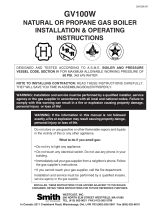
5
The Copper-fin - How it works...
1. Heat exchanger
The heat exchanger allows system water to flow through specially
designed tubes for maximum heat transfer. The glass lined
headers and copper fined tubing are encased in a jacket that
contains the combustion process.
2. Inner combustion chamber door
The inner combustion chamber door is a galvanized steel door which
allows access for service, maintenance, and removal of the
heat exchanger from inside the combustion chamber.
3. Blower
The blower pulls in air and injects air into the individual burners
along with gas from the gas manifold where the mix is burned in
the combustion chamber.
4. Gas valve
The gas valve allows the proper amount of gas to pass into the
burner for combustion. The gas valve is biased with pressure from
the combustion chamber to assist in regulation of the gas flow.
5. System / tank temperature sensor (not shown)
When connected, this sensor can be used as a system sensor or a
tank sensor.
6. Inlet temperature sensor
This sensor monitors inlet water temperature. If selected as
the controlling sensor, the appliance will maintain the set point
temperature based on the reading at this sensor.
7. Temperature and pressure gauge (boiler only)
The temperature and pressure gauge monitors the outlet
temperature of the appliance as well as the system water
pressure.
8. Diagnostic display
The diagnostic display consists of six (6) lamps used to show all
the major steps of operation and control malfunctions.
9. Burner
The burner is a ported stainless steel construction which uses a gas
air mix to operate at a fixed input. Banks of burners are turned on
or off to vary the firing rate.
10. Water outlet (system supply)
The water outlet is a pipe connection that supplies water to the
system with connections for a flow switch (see #25), a relief valve
(see #22), and a temperature and pressure gauge (boilers only)
(see #7).
11. Water inlet (system return)
The water inlet is a pipe connection that receives water from the
system and delivers it to the heat exchanger.
12. Gas supply pipe
The gas supply pipe on this appliance is 1 1/4'' diameter (Models
497 - 747) and 2" diameter (Models 987 - 2067) NPT. Please
reference the National Fuel Gas Code charts for connection
details.
13. Two-Stage Electronic Temperature Control
The electronic temperature control provides two-stage (high / low
fire) operation by monitoring system demand.
14. Air intake
Fresh air for combustion is drawn through a filter provided at the
air intake, located at either the rear or right side of the appliance.
15. Line voltage terminal strip
The line voltage terminal strip provides a location to connect
all of the line voltage (120 VAC) contact points to the unit.
16. Low voltage connection board
The low voltage connection board provides a location to tie in
all of the low voltage contacts to the appliance. This is where most
of the external safety devices are connected to the unit such as
the louver proving switch.
17. Front doors - upper and lower
The front doors provide access to the gas train as well as the
blower, burners and other key components for service and
maintenance.
18. Hot surface igniter (HSI)
The hot surface igniter is a device that is used to ignite the
air/gas mixture as well as monitor the performance of the flame
during operation. This device acts as a flame sense electrode.
19. Flame inspection window (sight glass)
The flame inspection windows, located on either side of the
appliance, allow for visual inspection of the burners and flame
during operation.
20. Gas shut off valve (downstream test cock)
The downstream test cock (when supplied) is in the gas train to ensure
complete shut off of the gas to the burner in case of
maintenance, inspection, or testing of the valve.
21. Manual high limit
Device that monitors the outlet water temperature to ensure
safe operation. If the temperature exceeds its setting (field
adjustable), it will break the control circuit, shutting the
appliance down.
22. Relief valve
The relief valve is a safety device that ensures the maximum
pressure of the appliance is not exceeded. Boilers operate on
pressure only and are shipped from the factory at a rating of
50 PSI. Water heaters operate on temperature and pressure and
are shipped standard as 150 PSI and 210°F (98.9°C).
23. Power switch
The power switch is used to engage and disengage power to the
appliance on the 120 VAC circuit.
24. Air pressure switch
The air pressure switch is a safety device which ensures proper
blower operation. The air pressure switch is wired in series with
the low voltage control circuit in such a way that if the fan does not
engage or shuts down prematurely the device will break the
control circuit and the unit will shut down.
25. Flow switch
The flow switch is a safety device that ensures flow through the
heat exchanger during operation. This appliance is low mass and
should never be operated without flow. The flow switch makes
contact when flow is detected and allows the unit to operate. If
flow is discontinued during operation for any reason the flow
switch will break the control circuit and the unit will shut down.
26. Drain port(s)
Location from which the heat exchanger can be drained.
27. Manual shutoff valve (not shown)
Manual valve used to isolate the unit from the gas supply.
28. Flue pipe
A pipe like enclosure that is placed over an appliance to improve
natural upward convection of heat and thereby increase the
dissipating ability of the appliance.
Installation & Service Manual





















